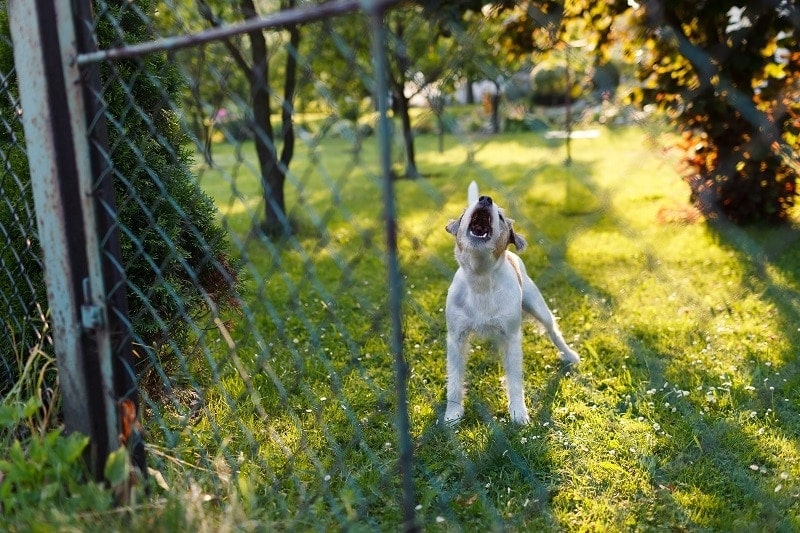Why Does My Dog Bark at Kids? 6 Reasons & How to Stop It
Updated on

Dogs bark for many different reasons. Sometimes it’s because they want to play, but other times, barking can be a sign of aggression. If your dog is barking at kids, you’ll want to get to the bottom of the reason right away to avoid any possible incidents.
A dog barking at kids is not always a bad thing, as the bark can be playful or aggressive, and learning the difference is vital. In this article, we’ll break it down and list the possible reasons so that you can address the issue.
Top 6 Reasons Dogs Bark at Kids
1. The Dog Didn’t Get Socialized Early Enough
Early socialization is critical for any dog to keep it from being fearful of its surroundings, especially children. For puppies, the early socialization window is usually between 6–14 weeks of age. During this time, a puppy should be introduced to children to establish trust.
Puppies at this stage are impressionable and curious about all things, and it is during this time that you’ll want to desensitize your puppy. Children touch dogs differently than adults. They may touch the dog’s face, tail, and ears and may even tug a bit on the dog.
Children stand at about the same level as a dog’s face, so the impulse to touch the dog’s face is strong. If a puppy is introduced to children during this window, they will become accustomed to children and not become fearful. An important note is always supervising playtime and never leaving children unattended with a new puppy or dog.

2. Teach Children to Be Respectful of Dogs
No dog or puppy will enjoy a child playing rough. Children need to be taught how to treat dogs respectfully. In other words, teach children not to pull on the dog’s ears or tail. Children may think this is a fun activity, but the dog may become agitated, and the memory can become ingrained in their heads, which will more than likely spark aggression the next time the child puts a close hand on those body parts.
Screaming can become a stressor for puppies, which will instill in a dog’s head in the future. Teaching a child to be calm around a new puppy will go a long way. Being kind and gentle with a soothing voice will teach the dog that the child is not a threat.
3. Understand Pet Boundaries
All dogs need quiet time, and these times are when they are eating, sleeping, or in their crate. If a puppy or dog is bothered while eating, it could spark food guarding. Before a pup is weaned, they may need to be aggressive in eating because they have to share the feeding bowl with its siblings. If a child bothers the pup during this time, the pup may feel threatened, and if not addressed early, this can carry over when the dog is an adult, which can be risky.
It’s best to nip this in the bud early by teaching your child or children to leave the dog alone during feeding time.

4. Learning Basic Commands
Training a puppy or dog is vital in preventing unwanted behaviors. As for children, involve them in the training process once the puppy or dog has learned some basic commands, such as sit, stay, shake, and down. Involving your child in the training process teaches the puppy or dog to obey commands from the child, and it teaches appropriate behavior between the child and dog.
5. Appropriate Play
Playing with your puppy or dog is a wonderful opportunity for bonding, and this is especially true for children. Teach your child to play calmly with the pup and avoid roughhousing. A game of fetch is fun for both the child and the dog, but always supervise them in case the dog accidentally knocks the child down. A good way to avoid this is by teaching the dog basic commands.
- Related Read: Are Australian Shepherds Good With Kids?

6. Monitoring Strangers
Just because you have taught your children to be respectful around dogs does not mean all children have learned this behavior. Suppose your child has a friend that is rambunctious. In that case, it may be best to avoid any interaction between the dog and that particular child until that child has been advised how to appropriately interact.
Conclusion
As you can see, there are many reasons why a dog may bark at children, and it’s vital to teach children how to treat dogs respectfully. The CDC reports that an estimated 800,000 people require medical attention for dog bites each year, and half of those are children. Most dog bites are preventable, and if you take the steps from above in this article, you’ll have harmony between your dog and your child with little to no barking.
Featured Image Credit: Canon Boy, Shutterstock












